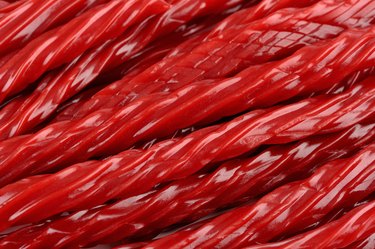
Referred to as "sweet root," licorice is used in both Eastern and Western medicine to treat conditions such as peptic ulcers. However the red licorice found down your candy aisle contains none of this root, according to the USDA.
There are many licorice side effects and possible drug interactions with the pure form of this herb. However, as with other candy, red licorice is a generally safe treat to add to your diet in moderation.
Video of the Day
Video of the Day
Tip
Like other types of candy, red licorice is generally safe to add to your diet when consuming it in moderation.
Consider Licorice Side Effects
Licorice supplements are available at many alternative health stores. Some of the purported benefits of licorice root include treatment of ulcers, eczema, obesity, bronchitis, heartburn and underactive adrenal gland function. However, few studies are available to support the efficacy of purported uses.
True black licorice root has many potential side effects, including lowering potassium levels and raising blood pressure, which can lead to muscle and heart problems, according to the National Center for Complementary and Integrative Health. The licorice herbal supplement may also interact with several drugs including insulin and blood pressure medications. None of the licorice candy produced in the United States contains any of the true licorice herb.
Read more: The 20 Most Dangerous Candies
Red candy licorice contains artificial flavoring that makes it taste like licorice, but without the serious side effects or drug interactions. Artificial flavors mimic the flavor of the shrub, but contain none of the healing or dangerous properties of the herbal remedy.
Count Calories, Carbs and Sugars
Red licorice candy is a healthier choice than an ice cream sundae, however it still contributes to additional weight gain if you aren't mindful of portion size. A typical serving packs a large punch with 31 grams of carbohydrates and 13 grams of sugars, according to the USDA.
Licorice candy is a simple carbohydrate that will be converted to glucose quickly in your blood, possibly contributing to high blood glucose levels. Consuming licorice candy in excess may prove harmful to you in the long term. Hyperglycemia is of particular concern if you have diabetes, where the insulin required to control blood sugar isn't properly used by or available for your body, according to Cleveland Clinic.
Licorice Candy and Allergies
If you have celiac disease, otherwise known as gluten intolerance, red licorice may be bad for you. Celiac disease is a condition where gluten, a protein found in wheat and other grains, causes an immune response in the small intestine, according to the National Institute of Diabetes and Digestive and Kidney Diseases.
Red licorice candy contains wheat in its ingredients, making this candy harmful to your overall health and wellbeing. A wheat allergy, caused by sensitivity to wheat itself, could also make candy licorice problematic for you. This may lead to minor allergic symptoms, such as hives or a potentially life-threatening allergic response referred to as anaphylaxis, where your throat may swell and close, as described by Mayo Clinic.